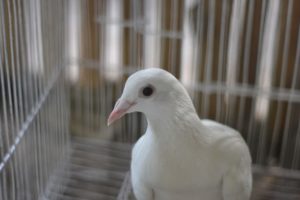Innovations in Bird Bath Design for Pet Birds

Pet birds, especially those that live in cages, require a suitable environment that meets their physical and psychological needs. One of the essential elements of such an environment is a bird bath, which helps maintain bird hygiene, feather health, and overall well-being.
However, traditional baths, like a bird feeder, often pose challenges when used in cages due to space constraints, water spillage, and difficulties in cleaning. This has led to innovative bird product designs that address these limitations and provide pet birds with a comfortable and engaging bathing experience.
This article will explore the latest innovations in bath design for pet birds, including space-efficient designs, leak-proof and splash-resistant features, easy-to-clean mechanisms, and enhanced comfort and safety features.
Whether you are a seasoned bird owner or considering getting a pet bird, this article will provide valuable insights and considerations for choosing the most suitable bird products for your feathered companion.
The Benefits of a Bird Bath for Pet Birds
All right, bird enthusiasts, let’s talk about why bird bath is such a big deal for our precious pet birds. Sure, they may seem like simple fixtures, but they play a vital role in our feathered friends’ lives.
Maintaining the Hygiene
The first function of baths is to maintain the right hygiene. Birds’ feathers need to be cleaned of dirt and dust, and to remove excess oil to look fabulous. Plus, it helps prevent feather plucking and soothes any itchy or irritated skin, ensuring our bird buddies are feeling their best.
Body Temperature Regulation
But it’s not just about looking good. Baths also play a significant role in temperature regulation because birds don’t sweat like we do. Instead, they rely on evaporation to cool down. They can dampen their feathers by hopping into a refreshing bath, and as the water evaporates, it helps them cool off on hot days.
Natural Behavior and Mental Stimulation
Birds are incredibly intelligent animals, and mental stimulation is the best way to keep them sharp and healthy. Beyond the physical benefits, baths offer mental stimulation and entertainment for our feathered pals. They provide an opportunity for natural behaviors, such as splashing, preening, and dunking, which are fun and mimic activities birds would engage in in the wild. This mental stimulation is crucial for their well-being, preventing boredom and ensuring a happy, chirpy companion.
Socialization and Bonding
Around the bath, birds, like people, interact with each other and engage in grooming behaviors. Baths have become a kind of socialization hub, especially in multi-bird households. Bathing experiences can strengthen bonds between birds and their human companions.
Stress Relief and Relaxation
Maybe you have never thought about this, but a bird bath provides a calming and soothing experience for birds, reducing stress and anxiety. This indispensable item from the cage brings tranquility and comfort to birds, helping them unwind and relax. That’s why a simple bath can have such a tremendous positive impact on stress relief on bird behavior and overall well-being.
Challenges of Traditional Baths for Caged Birds
When it comes to traditional baths, they may work wonders for our feathered friends in the great outdoors, but for pet birds living in cages, they often fall short. Let’s take a closer look at the challenges these traditional designs present and why there may be better fits for our caged companions.
One of the primary challenges is space constraints. Cages, by their nature, have limited room, and finding a bird bath that fits comfortably can be a real puzzle. Traditional baths may be too large or cumbersome for cage setups, leaving bird owners scratching their heads and trying to find creative ways to squeeze them in.
Another common issue is water spillage. Birds can be enthusiastic bathers, splashing and frolicking, but that joy often leads to a soaked cage floor. Traditional baths with shallow basins or inadequate splash guards can result in a watery mess, creating extra work for bird owners who need to clean up the aftermath.
Cleaning is yet another challenge with traditional baths. First, baths can get dirty, and cleaning them regularly is crucial for maintaining bird hygiene. However, some conventional designs make this task more complicated than necessary. Fixed structures, intricate components, or hard-to-reach areas can make cleaning time-consuming and frustrating.
These challenges can lead to frustration for bird owners and, in some cases, even discourage the regular use of baths. After all, who wants to deal with a cramped, messy, or difficult-to-clean bath?
Overcoming Challenges of the Bird Feeder
A traditional bird feeder may present obstacles in meeting the specific needs of pet birds in cages. However, with innovative feeder designs, these challenges are being addressed head-on. By choosing feeders that provide easy access, minimize waste, allow portion control, facilitate cleaning, and offer mental stimulation, bird owners can provide their feathered companions with a well-rounded and enjoyable feeding experience. Let’s see the main challenges when we use a feeder for our pets.
Limited Access and Feeding Space
Pet birds have limited access to natural food sources in a cage environment. A traditional bird feeder may not be designed to fit within the dimensions of a cage, making it difficult for birds to reach the food. This challenge becomes even more significant when multiple birds are housed together, requiring sufficient feeding space for everyone.
Feeders with adjustable extensions and flexible perches are now available, providing convenient access and accommodating the dimensions of various cage sizes.
Seed Waste and Spillage
Traditional feeders can lead to seed waste and spillage, resulting in unnecessary expense and creating a mess in the cage. Birds may scatter or flick seeds outside the feeder, leaving behind a trail of debris. Maintaining a clean and hygienic environment becomes challenging, and the risk of bacterial growth increases.
Anti-waste and spillage features, such as seed-catching trays and feeders with built-in covers, minimize mess and prevent seed waste.
Difficulty in Monitoring and Controlling Food Intake
Monitoring the food intake of pet birds in cages is essential for their overall health. However, traditional feeders offer limited control over food portions, leading to potential health risks such as overeating or inadequate nutrition. Pet birds may also manipulate the feeder and access food more frequently than necessary.
Portion control feeders and regulated access mechanisms ensure that birds consume appropriate food, promoting a healthy diet.
Maintenance and Cleaning
Regular cleaning of the bird feeder is crucial for maintaining bird health. However, cleaning traditional feeders within the confines of a cage can be challenging. Detaching and accessing all parts of the feeder for thorough cleaning may prove cumbersome, making it difficult to maintain a hygienic feeding environment.
Easy-to-clean feeder designs with removable components simplify maintenance and facilitate thorough cleaning for optimal hygiene.
Lack of Enrichment and Stimulation
Feeding time should provide nourishment and mentally engage and stimulate pet birds. Traditional feeders often lack interactive features, leaving birds with limited opportunities for mental stimulation, which can result in boredom and a lack of engagement during feeding.
Interactive feeders with puzzles, foraging elements, or treat-dispensing mechanisms add mental stimulation and turn feeding time into an engaging and enriching experience.
Conclusion
Using a traditional bird feeder or bath may be challenging for your custom cage. But by embracing some innovative bird product designs, bird owners can overcome the challenges faced with traditional items, ensuring a healthier, cleaner, and more engaging feeding experience for their pet birds in cages. This way, we can provide our beloved pet birds in cages with the best possible care and nourishment.


